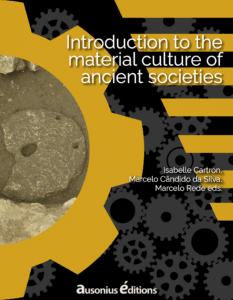UN@ est une plateforme d'édition de livres numériques pour les presses universitaires de Nouvelle-Aquitaine
Collection : V@demecum_3
Grave goods found inside Early Medieval tombs have aroused the interest of many since the moment they were buried in the ground. These artifacts continued to play different roles, even after the end of the Middle Ages
What did “barter” mean in ancient societies? Back at the times when men organized themselves in simple societies, people exchanged things, products, goods, in order to satisfy a vital need
par Stéphane Rottier
The protohistoric period in Europe is the theater of very diverse funeral treatments, from simple burial as it is most often envisaged, to cremation, including specific positioning, remodeling of tombs, recovery of bones, etc.
par Isabelle Cartron
The knowledge of ancient societies is expressed in a significant way through funerary remains.
par André Miatello
In the seventh century, Isidore of Seville (Etymologiae, XV, iii) defined habitation [habitatio] as having [habere] a place to live, which could be a ‘casa’ (i.e., a rustic hut), a ‘domus’ (the residence for a single family), an ‘aula’ (the royal residence) or an ‘atrium’ (a large and spacious dwelling).
par Haude Morvan
In medieval Western Europe, religious and lay communities practiced common prayers in dedicated places, with special furniture and objects. For the monks, they were mainly in the choir stalls of the church and the chapter house
par Leonardo Fuduli
The cathedral of Messina, locally called ‘Duomo’, is currently a unique building not only for its historical and artistic importance but also for the singular events that have affected it in the last centuries: two earthquakes (1783; 1908) and one bombing (1943).
The last centuries of Antiquity were marked by the spread of Christianity and its growing influence on Western societies. Its expansion was encouraged by the members of the clergy that was being set up, as well as by the circulation of people and ideas within an Empire that made it its official religion in 380.
Recently, knowledge of the ancient habitat during Antiquity has benefited from the multiplication of preventive excavations, from the contribution of programmed excavations, but also from data obtained from pedestrian, aerial and geophysical prospection.
par Isabelle Cartron
The Western Middle Ages were strongly marked by the emergence and affirmation of Christianity: being part of the Ecclesia (i.e. the community of Christians) it became a frame of reference that was reflected in many individual and collective practices.
par Leandro Ranieri
This is a typical siege scene in the Assyrian palaces. Recurrently, war scenes were placed in the walls of throne rooms (besides some symbolic and protective images).
par André Miatello
Archeological excavations and aerial revelations show that the larger villae continued to develop until the 5th century, while the smaller ones were abandoned between the 2nd and 3rd centuries.


